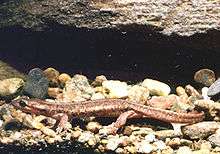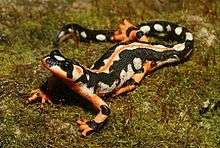Euproctus
Euproctus, the European mountain salamanders, is a genus of salamanders in the family Salamandridae from Sardinia and Corsica.[1]
| Euproctus | |
|---|---|
 | |
| Euproctus montanus | |
| Scientific classification | |
| Kingdom: | Animalia |
| Phylum: | Chordata |
| Class: | Amphibia |
| Order: | Urodela |
| Family: | Salamandridae |
| Subfamily: | Pleurodelinae |
| Genus: | Euproctus Gené, 1838 |
| Type species | |
| Euproctus rusconii Gené, 1838 | |
| Diversity | |
| 2 species (see text) | |
Species
- Euproctus montanus (Savi, 1838) – Corsican brook salamander
- Euproctus platycephalus (Gravenhorst, 1829) – Sardinian brook salamander
The Pyrenean brook salamander used to be included in this genus as Euproctus asper, but was moved to Calotriton in 2005.[3][4] Its superficial similarity with Euproctus likely represents convergent evolution: strongly depressed head and body, and reduction or even absence of lungs, are adaptations to fast-running, well-oxygenated mountain streams.[4]
gollark: You forgot to handle <img> also.
gollark: How does it handle errors generally?
gollark: I mean, most of the validator warnings *are* just "not allowed in this context" and it's harder to process that standards-compliantly than to ignore it, but still.
gollark: My site is designed to work okay with no/old JS and >=IE11 CSS, but many things aren't, and I only test for firefox.
gollark: Oh, and half the stuff on the web uses JS... good luck with that.
External links
![]()
References
- Frost, Darrel R. (2014). "Euproctus Gené, 1838". Amphibian Species of the World: an Online Reference. Version 6.0. American Museum of Natural History. Retrieved 9 March 2015.
- "Salamandridae". AmphibiaWeb: Information on amphibian biology and conservation. [web application]. Berkeley, California: AmphibiaWeb. 2015. Retrieved 9 March 2015.
- Frost, Darrel R. (2014). "Calotriton Gray, 1858". Amphibian Species of the World: an Online Reference. Version 6.0. American Museum of Natural History. Retrieved 9 March 2015.
- Carranza, S.; Amat, F. (2005). "Taxonomy, biogeography and evolution of Euproctus (Amphibia: Salamandridae), with the resurrection of the genus Calotriton and the description of a new endemic species from the Iberian Peninsula". Zoological Journal of the Linnean Society. 145 (4): 555–582. doi:10.1111/j.1096-3642.2005.00197.x.
This article is issued from Wikipedia. The text is licensed under Creative Commons - Attribution - Sharealike. Additional terms may apply for the media files.
